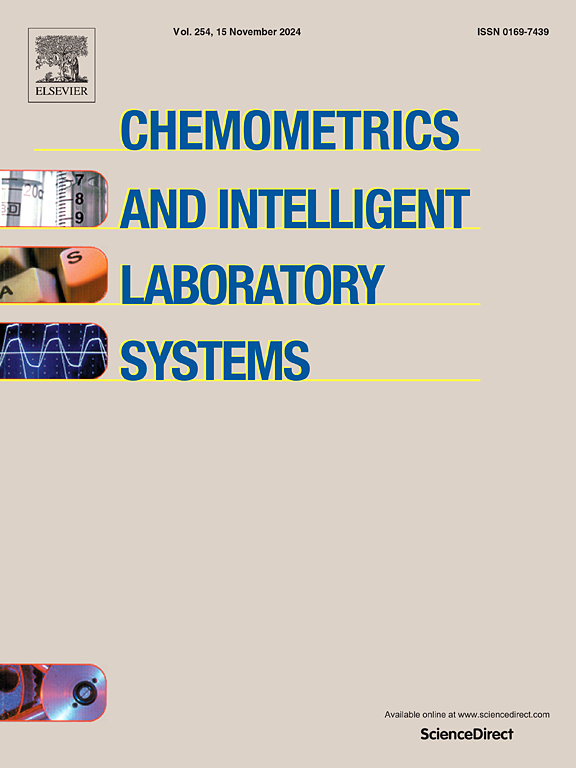Wine variety traceability by data fusion of near-infrared(NIR) spectroscopy and mid-infrared (MIR) spectroscopy combined with GAF and ResNet
IF 3.8
2区 化学
Q2 AUTOMATION & CONTROL SYSTEMS
Chemometrics and Intelligent Laboratory Systems
Pub Date : 2025-06-12
DOI:10.1016/j.chemolab.2025.105468
引用次数: 0
Abstract
Wine varietal authentication is critical for ensuring quality and preventing market fraud. Spectroscopy method is commonly used for rapid and nondestructive analysis of wine varieties, but the method typically rely on one-dimensional(1D) spectrum inputs and conventional machine learning algorithms, limiting complex compositional feature capture and reducing classification accuracy. To address these challenges, this study proposes a novel wine varietal tracing approach integrating NIR and MIR spectroscopy, Gramian Angular Field (GAF) image encoding, and ResNet-based deep learning. The NIR and MIR spectra of 172 wine samples from three grape varieties: Cabernet Sauvignon, Merlot, and Cabernet Gernischt were collected. Spectral fusion and data augmentation techniques constructed fused spectra and expanded the dataset to 1720 samples. Then the 1D NIR, MIR, and fused spectra were transformed into two-dimensional(2D) images using GAF encoding, creating Gramian Angular Difference Field (GADF) and Gramian Angular Summation Field (GASF) representations. These images were fed into a deep residual network (ResNet) for varietal classification respectively. The designed ResNet architecture incorporates residual blocks and attention mechanisms, significantly enhancing feature extraction and classification performance. Experimental results show that the proposed model achieves 100 % classification accuracy on the test set, outperforming traditional machine learning methods and 1D-CNN. The result indicates that the integrating of infrared spectroscopy, GAF image encoding, and ResNet is a feasible approach for wine varietal tracing, providing a novel solution for food quality tracing analysis.
近红外(NIR)光谱与中红外(MIR)光谱结合GAF和ResNet数据融合的葡萄酒品种溯源
葡萄酒品种认证是确保质量和防止市场欺诈的关键。光谱法通常用于葡萄酒品种的快速无损分析,但该方法通常依赖于一维(1D)光谱输入和传统的机器学习算法,限制了复杂的成分特征捕获并降低了分类准确性。为了解决这些挑战,本研究提出了一种新的葡萄酒品种追踪方法,该方法集成了近红外和MIR光谱、格拉曼角场(GAF)图像编码和基于resnet的深度学习。采集了赤霞珠、梅洛和德国赤霞珠3个葡萄品种172份葡萄酒样品的近红外光谱和红外光谱。光谱融合和数据增强技术构建了融合光谱,并将数据集扩展到1720个样本。然后利用GAF编码将一维近红外光谱、MIR光谱和融合光谱转换为二维(2D)图像,创建格拉曼角差场(GADF)和格拉曼角和场(GASF)表示。将这些图像分别输入深度残差网络(ResNet)进行品种分类。设计的ResNet体系结构结合残差块和注意机制,显著提高了特征提取和分类性能。实验结果表明,该模型在测试集上的分类准确率达到100%,优于传统的机器学习方法和1D-CNN。结果表明,红外光谱、GAF图像编码和ResNet相结合是一种可行的葡萄酒品种溯源方法,为食品质量溯源分析提供了一种新的解决方案。
本文章由计算机程序翻译,如有差异,请以英文原文为准。
求助全文
约1分钟内获得全文
求助全文
来源期刊
CiteScore
7.50
自引率
7.70%
发文量
169
审稿时长
3.4 months
期刊介绍:
Chemometrics and Intelligent Laboratory Systems publishes original research papers, short communications, reviews, tutorials and Original Software Publications reporting on development of novel statistical, mathematical, or computer techniques in Chemistry and related disciplines.
Chemometrics is the chemical discipline that uses mathematical and statistical methods to design or select optimal procedures and experiments, and to provide maximum chemical information by analysing chemical data.
The journal deals with the following topics:
1) Development of new statistical, mathematical and chemometrical methods for Chemistry and related fields (Environmental Chemistry, Biochemistry, Toxicology, System Biology, -Omics, etc.)
2) Novel applications of chemometrics to all branches of Chemistry and related fields (typical domains of interest are: process data analysis, experimental design, data mining, signal processing, supervised modelling, decision making, robust statistics, mixture analysis, multivariate calibration etc.) Routine applications of established chemometrical techniques will not be considered.
3) Development of new software that provides novel tools or truly advances the use of chemometrical methods.
4) Well characterized data sets to test performance for the new methods and software.
The journal complies with International Committee of Medical Journal Editors'' Uniform requirements for manuscripts.

 求助内容:
求助内容: 应助结果提醒方式:
应助结果提醒方式:


